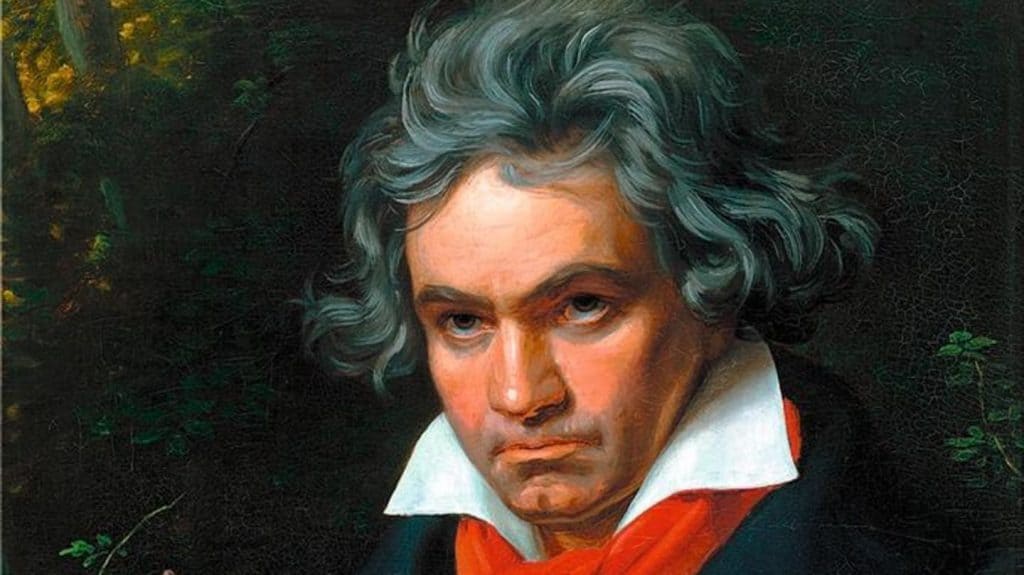“Moonlight Sonata” by Ludwig van Beethoven is one of the staple pieces of classical piano music. Its haunting melody, darkly dreamy tempo, and characteristic chord progression make it a piece that is both well-loved and often played. Like other standard pieces of classical piano music, beginners might not know the history and stories behind the “Moonlight Sonata” and why pieces such as this have become canonical parts of the repertoire in the first place. This week, let’s dive into the history of “Moonlight Sonata” and learn some facts about the defining parts of the piece.

The story behind “Moonlight Sonata”
Like many other pieces of standard classical piano repertoire, the “Moonlight Sonata” has a nearly legendary backstory. Afterall, when a piece of art has existed in the popular consciousness for over 200 years, it is natural for stories and myths about the best piano songs to appear.
The origins of the piece
Beethoven originally composed Piano Sonata No. 14 in C-sharp minor, marked Quasi una fantasia, Op. 27, No. 2 in 1801. The piece was completed when Beethoven was in his thirties.
Who is the piece dedicated to?
Nearly all composers of Beethoven’s era had either patrons or were employees of the church or academy. As such, many of the most famous (and not so famous) pieces of classical piano repertoire are dedicated to this or that wealthy patron.
Beethoven was a new breed of musician though. He often scorned the necessity of having patrons and felt that his music represented something beyond. However, the “Moonlight Sonata” is dedicated to Beethoven’s student, the Countess Giulietta Guicciardi. Guicciardi is purported to be the “Immortal Beloved” that Beethoven addressed three unsent letters to that were found at the time of his death.
What is the reason behind the name?
As we have learned, Beethoven did not originally title this work “Moonlight Sonata.” His original mark was Quasi una fantasia, or “like a fantasy.”
Like many legends, the name of this sonata emerged after Beethoven’s death in 1827. Some years after the composer’s death, the music critic Ludwig Rellstab remarked that the piece was like the reflection of the moon on Lake Lucerne.
Beethoven’s student, Carl Czerny, a pianist and scholar worth studying in his own right, remarked that the piece had a mournful, ghostly sound and a nocturnal feeling. However, there is some disagreement among other music critics who believe the piece to be much more mournful than enchanting.
Playing “Moonlight Sonata” on piano
Most beginner to intermediate piano students will encounter the first movement of the “Moonlight Sonata” at some point. The first movement is titled “Adagio sostenuto”, meaning slow and held.
How difficult is “Moonlight Sonata” to play on the piano?
There are three movements total in the “Moonlight Sonata.” Additionally, there are simplified versions available. The original versions of the piece are difficult and should be reserved for intermediate to advanced pianists. The stretches in the right hand can be expansive and the number of key changes and reading of sharps and double sharps can be exhausting for the beginner.
However, there are many simplified versions, of the first movement in particular, that are well suited for the beginner. By modulating the piece to an easier key, like E minor for example, the composition becomes an easy piano song.
The Skoove lesson on “Moonlight Sonata” is in the key of D minor, which is much easier to practice than the original key of C♯ minor! This is one of the many advantages to online piano lessons.
What sets “Moonlight Sonata” apart from other pieces?
Why is the “Moonlight Sonata” such a legendary piece? What sets the piece apart from other similar works of classical piano music? Perhaps it is the immediate and powerful imagery of the piece. If you have not listened yet to a true professional perform the piece, start here with Claudio Arrau:
Listen to the slight rubato motion of his performance. He slows down and speeds up the phrases at the beginning and at the end to draw the listener into his performance. Listen to the points of emphasis, particularly in the left hand, and the ebb and flow of the dynamics. How many times do you hear the initial melody repeated?
Here is another version of “Moonlight Sonata” performed by the phenomenal Alicia Keys, with a string quartet accompaniment:
How does this performance differ from the Arrau version to you? Apart from the obvious difference of the string quartet. How does each pianist approach the shape of the phrases? Which performance do you think delivers stronger emotional impact? Why? Thinking about and studying various performances of famous pieces like “Moonlight Sonata” will give us insight into how we can make our own performances of these pieces memorable and moving.
Curious facts
- Beethoven’s piece is called a sonata, but it does not follow the “traditional” sonata form.
- The second movement of the sonata is composed in D♭ major, while the first and third are in C♯ minor. Why would the composer do this, do you think?
- The pedal indications on Beethoven’s “Moonlight Sonata” piano sheet music indicated the piece should not be played with dampers. On modern pianos, that means we either need to lift the pedal with each harmonic change to avoid dissonance, or use a technique like “half-pedaling”, where the sustain pedal is slightly depressed.
Summing it up
Ludwig van Beethoven’s “Moonlight Sonata” is one of the staples of classical piano music. Almost every student of classical piano will encounter the piece at some point in their lives. However, not every student will learn the history behind the piece and what some of the defining characteristics are.
With Skoove, you can learn all of this and more! With over 400 lessons on repertoire, theory, and technique and an extensive educational blog section covering topics from history to specific songs and styles, you can access a huge universe of exciting material with Skoove. Give it a test this week and see just how much you can learn!
Author of this blog post:

Eddie Bond is a multi-instrumentalist performer, composer, and music instructor currently based in Seattle, Washington USA. He has performed extensively in the US, Canada, Argentina, and China, released over 40 albums, and has over a decade experience working with music students of all ages and ability levels.














